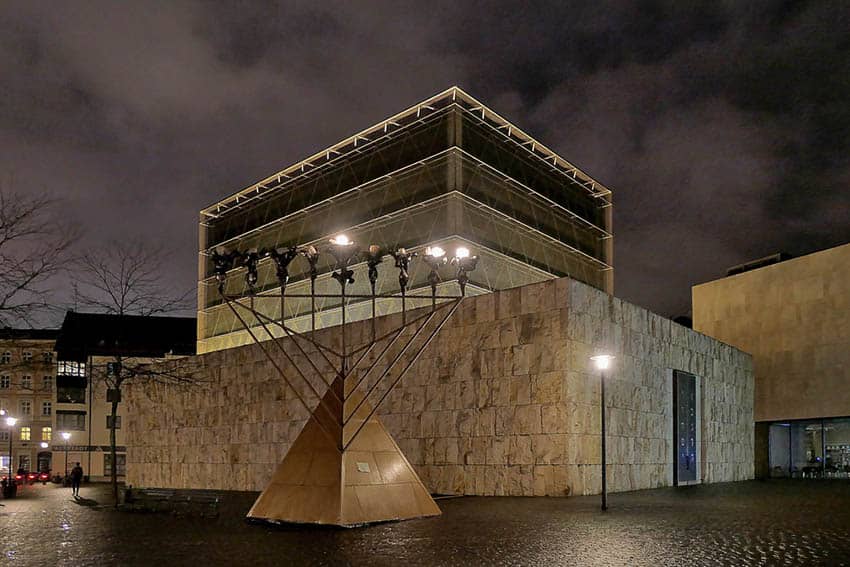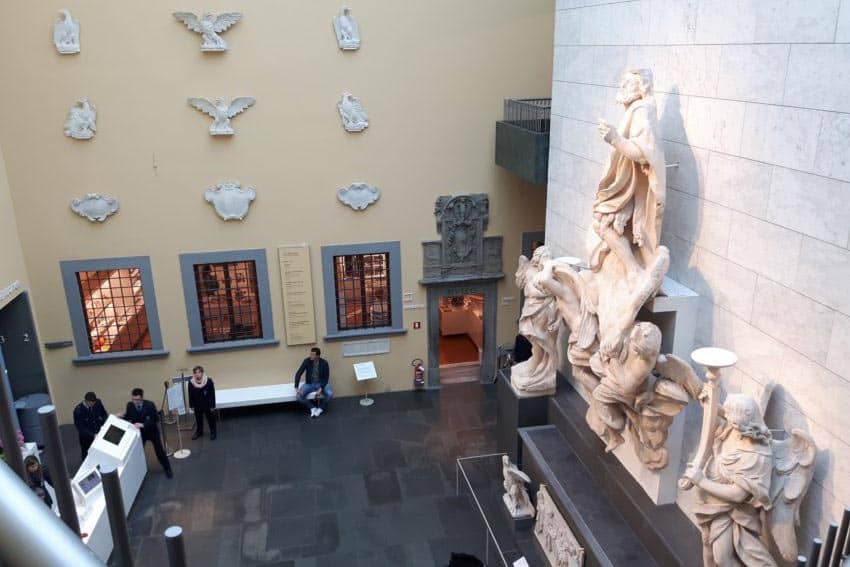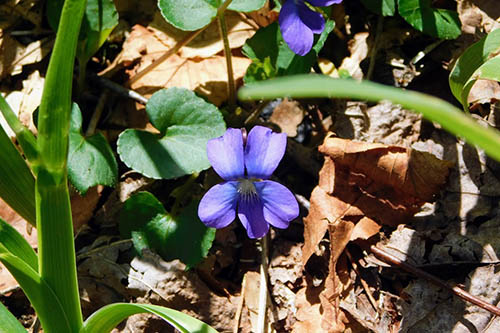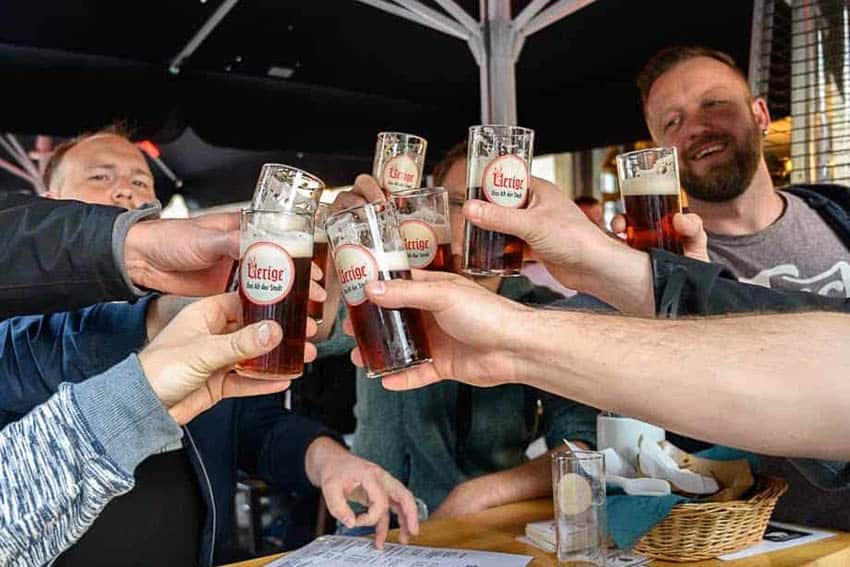
Dresden Germany is Full of Surprises–and Totally Rebuilt like the 1800s
By Simon Glassock

For many people, the name ‘Dresden’ is likely to be synonymous only with the Allied carpet bombing of February 1945 and the resulting firestorm that destroyed much of the city and killed between 35,000 and 135,000 people, though the exact number is still disputed and maybe even more.
Certainly, parts of Dresden are still visibly recovering from the destruction but much of the Altstadt (Old Town), including its iconic church, the Frauenkirche, has been sensitively rebuilt and restored while the Neustadt (New Town) on the north bank of the Elbe was largely untouched by the bombing.
Florence of the North
However, with respect to those who died, indeed in tribute to them, I discovered that the city once known as ‘the Florence of the North’ deserves to be known again as much for its sophistication, vitality and gorgeous surrounding countryside as for the horrific events of the dying months of the Second World War.
Located in the far east of the country only a few miles from the present borders of Poland and the Czech Republic, Dresden is the state capital of Saxony, as it has been for over 500 years.
It was under Augustus II, ‘the Strong’, (1670-1733) and his son, Augustus III (1696-1763), both of whom were Electors of Saxony and Kings of Poland, that the city achieved its greatest renown and the refined and cultured Aldstadt with its regal Baroque architecture and world-class art collections and museums is largely of their creation.

But Dresden’s coin has two sides. The Neustadt on the north bank of the Elbe is more mixed, both in architecture and entertainment, and is known for its contemporary art galleries, courtyard theatres and bars with Apple Mac-toting clienteles.
North and South Banks of the Elbe
Dresden’s north and south banks are a marvelous complement to each other and together provide the tourist with a wide range of superb attractions, fine cafes and restaurants, friendly service and great beer.
As if these delights were not enough, the extensive local transport system offers easy access to the charming towns of Görlitz and Pirna, as well as to the spa town of Bad Schandau, set amid the forests and sandstone towers of Sächsische Schweiz (Saxon Switzerland).
In fact, in only one week it is possible to comfortably and unhurriedly visit all of these places, combining high culture, low ceilings, sweeping panoramas, ancient hilltop fortresses and even a leisurely bike ride along the banks of the Elbe.
Don’t believe me? The brief itinerary at the end of this piece shows how I organized things but remember, it’s only one example of how this multi-faceted region can be enjoyed.
Arrivals, transfers, and accommodation in Dresden
We flew into Dresden and found that transfers to the city center are joyfully easy. Modern double-deck trains take passengers into Dresden every thirty minutes from the airport rail station which is conveniently situated on the basement level of the terminal building. Trains go to Dresden Neustadt and Dresden Hauptbahnhof, both of which are also interchanges for regional and interregional lines.

As I was staying at the Ibis Hotel Lilienstein I got off at Dresden Hauptbahnhof. Somewhat confusingly the Dresden Ibis is actually composed of three related but separate hotels, but all are located only a short walk from the station down the spacious and pedestrianized Prager Strasse shopping street.
Make no mistake, although the rooms are small and a touch basic the Ibis offers value for money with helpful staff in a clean and quiet part of Dresden which is very convenient for the Altstadt and its many attractions.
No visit to Dresden would be complete without seeing Frauenkirche
If one building has become synonymous with Dresden it is the Frauenkirche. This monumental church was destroyed in the 1945 bombing raid and deliberately left in its shattered state by East Germany to act as a reminder of the horror of war.
After German reunification donations from around the world helped restore it to its former glory and the Frauenkirche once again dominates the Altmarkt (Old Market).
The interior is a pastel-colored confection but its most arresting feature is the vast dome that punctuates the Dresden skyline and which has come to visually represent the entire city. The church has become a symbol of peace and reconciliation, especially between the twinned cities of Coventry and Dresden, both of which were heavily bombed during the Second World War and both of which lost their cathedrals to the flames.
The two are spiritually linked by the donation to the Frauenkirche of the Coventry Cross of Nails, constructed from three carpenter’s nails that were taken from the medieval beams of the ruined English cathedral in 1940.
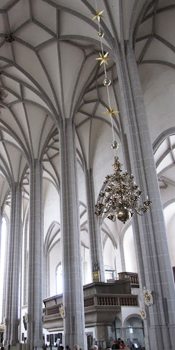
Dresden’s Incredible Museums
Dresden’s museums and galleries are without exaggeration second to none. My particular favorites from the Zwinger were the Gemäldegalerie Alte Meister (Old Master Paintings Gallery), Porzellansammlung (Porcelain museum) and Rüstkammer (Armoury) and from the nearby but quite distinct Residenzschloss the Historisches Grünes Gewölbe (Historic Green Vaults) and the Neues Grünes Gewölbe (New Green Vaults).
None of these should be missed, no matter that you may think you are not really interested in, say, porcelain or weapons and armor. The Gemäldegalerie Alte Meister contains a ravishing collection of paintings, including several views of the Elbe and the Neumarkt by Bernardo Bellotto, nephew of the Venetian master, Canaletto.
Minutely detailed early Northern Renaissance paintings by artists such as Jan van Eyck, intimate Dutch genre scenes, monumental canvases by Italian masters of the seventeenth century and, most famously, Raphael’s ‘Sistine Madonna’ with its two cheeky putti leaning out of the frame and inviting the viewer to adore the Virgin and Christ child.
Paintings in the Zwinger
My special highlights from the Zwinger were the superlative collection of paintings by Cranach the Elder and his son, the Younger, in the Gemäldegalerie Alte Meister, the Türckische Cammer (Turkish Room) in the Rüstkammer and the Böttger brown stoneware in the Porzellansammlung.
This exquisite material was one Johan Böttger’s steps towards unlocking the secret of producing true, hard-paste white porcelain at Dresden in the early eighteenth century for his patron-jailer, Augustus the Strong.
Augustus had conceived an obsession for porcelain and imprisoned poor Böttger until he was successful in discovering its manufacture, following which the world-famous Meissen factory was founded in 1710.
I was entranced by the luster of Böttger ware’s polished surface and the depth of its shades of red and brown. Images do these pieces little justice, whose subtle beauty can only really be appreciated at close quarters.
It is worth noting that the Historisches Grünes Gewölbe gets very busy and it would be a good idea to buy tickets in advance (which we failed to do) whereas tickets for the Neues Grünes Gewölbe can be bought on the day. However, any disappointment you may feel at not being able to see the Historic Vaults will soon be dispelled for the New Vaults contain an exquisite collection of royal gifts, jewelry, carvings and statuettes, assorted ephemera and decorative pieces.
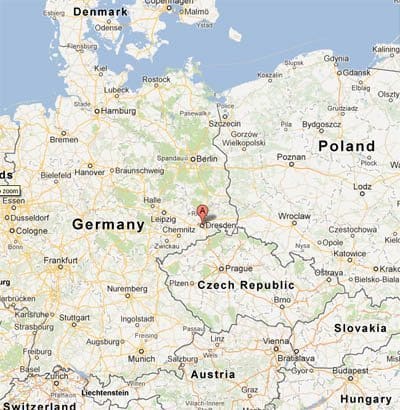
Wandering Dresden
As in so many cities, part of the pleasure of experiencing Dresden is to simply wander and for wandering Dresden is blessed with the Brühlsche Terrasse which runs along the south bank of the Elbe.
Once called ‘Europe’s terrace’ this is a fine place to promenade, watch the Elbe paddle steamers roll by and admire the glass dome of the Kunsthalle im Lipsiusbau, known locally as the ‘Lemon Squeezer’.
Honest German Food
I am a big fan of German cuisine. German food is open and honest with big, unabashed flavors served on big, unashamed plates.
I remember eating pork, fish, poultry and even vegetables but these are all overshadowed by one dish which I chose time and again – the German ‘signature dish’ of sauerbraten (marinated beef) with red cabbage and potato dumplings. Sauerbraten and a great draught of German beer after a day in the Cranachs – it really doesn’t get much better.
I chose to have my breakfasts immediately opposite the hotel foyer in the Schwerdtner Bäckerei. This is part of a German coffee shop and bakery chain which offers a number of breakfast options in comfortable and unhurried surroundings. Sticking with the cheap-and-cheerful theme we decided one evening to eat early and went to a branch of the self-service Nordsee restaurants.
Sometimes all you really want is a quick meal that isn’t composed mainly of dough and grilled meat and Nordsee offers a good selection of tasty, reasonably priced seafood. Try it; I think you’ll be pleasantly surprised.
Close to the Semper Opera on Theaterplatz we had a meal in the decorated Beer Saloon at the Italienisches Dörfchen. We were again eating at a slightly odd hour, this time in the late afternoon, and although the place was empty the service was prompt and friendly and the food was delicious.

While visiting the Old Masters gallery in the Zwinger we took a break from the wealth of art to have coffee and a pastry at the elegant Altemeister cafe, which converts to a full restaurant in the evening.
The slightly more upbeat cafe at the Residenzschloss is found alongside the ticket counters and information desks and is a convivial place to sit and watch the visitors come and go.
Augustus the Strong
Still in the Alstadt, the distinctly ‘Augustus the Strong’ themed Sophienkeller restaurant in the Taschenbergpalais close to the Zwinger is a lively and fun place to eat. It is a pleasantly confusing warren of stairways, walkways and interconnected vaulted cellars with plenty of space for tables small and large.
We ate in one of the smaller rooms which was almost filled by a large and good-natured group of Germans enthusiastically belting out what I assumed were well-known but old-fashioned folk songs, judging by the self-conscious smiling and mumbling of the younger members of the party.
They may have been slightly embarrassed by their older friends and relations but it made for a warm and entertaining evening for us. Across the river in Neustadt, we went twice to the Watzke Brauereiausschank am Goldenen Reiter, a spacious restaurant which also has alfresco tables facing onto Hauptstraße.
It brews its own beer, has a good menu and is popular with local Dresdeners who come to catch up over a litre or two or to linger over tasty dishes such as pork knuckles, which are much nicer than they may sound.

Around and about Dresden 1: Görlitz
Görlitz is only a short train ride from Dresden and is one of the few German towns not badly damaged during the Second World War. It is a treasure house of more than 4000 listed Gothic, Renaissance, Baroque and art nouveau buildings, and what you see here is original, though often carefully restored, rather than the sensitive and skillful rebuilding which is common in many other towns and cities.
For reasons I can’t fully explain, I most vividly remember the Art Nouveau Karstadt department store, the luminous interior of the late Gothic Peterskirche, and the replica of the Holy Sepulchre, which was a popular destination for medieval pilgrims unable to make the journey to the original site of Christ’s crucifixion and tomb at Calvary in Jerusalem.

Pop Over to Poland
Perhaps I was so blinded by the wealth of architecture in Görlitz that only the vast and the curious remain firmly imprinted on my mind’s eye. From Görlitz you can also take a short and inexpensive trip into Poland by simply walking across the bridge over the River Neisse into neighbouring Zgorzelec, once part of Görlitz itself but a Polish town since the end of the Second World War.
The only reason I crossed the bridge was for the schoolboy fun of saying ‘Now I’m in Germany, now I’m in Poland, now I’m in Germany, now I’m in Poland’.
Around and about Dresden 2: Bad Schandau, Sächsische Schweiz (Saxon Switzerland) National Park and Pirna Saxon Switzerland is a well kept German secret. Here the Elbe runs in a peaceful valley between lushly forested hills and rolling green pastures. The pretty little town of Bad Schandau is an ideal base from which to explore the area.
I stayed at the Apparthotel Am Schlossberg. This is a modern and airy hotel that offers a range of accommodation, from huge double/family rooms to apartments with kitchenettes. I had booked a room with a kitchenette but instead had a vast bathroom. On querying this I discovered that we had inadvertently been put in the wrong room but it then dawned on me that the bathroom was actually disabled-friendly.
Wheelchair Friendly

In fact, the hotel appears to have been entirely though unobtrusively designed so that it can accommodate disabled guests. Seeing wheelchair users at breakfast brings one to a sudden and rather guilty realization of how limited disabled people’s holiday options must be. Happily the Apparthotel Am Schlossberg now makes the beautiful region of Saxon Switzerland accessible to almost everyone.
From Bad Schandau we visited the famous Bastei, the fortress at Königstein, where poor old Böttger was imprisoned in 1706, and Pirna. All are easily accessible from Bad Schandau by public transport. I found local buses a good option as the timetables leave plenty of time to see everything and they have the advantage of taking you through places that you would never see from a train or boat and of giving a glimpse of daily life as local people hop on and off.
The Bastei is a striking outcrop of interconnected sandstone towers rising out of the woods above the Elbe opposite the village of Rathen. From various viewpoints, they offer stunning panoramas of the river’s course and the surrounding countryside, including the Königstein eyrie.
The Königstein fortress was built in the sixteenth century on the hilltop site of a pre-existing castle, far above the small riverside town below. The fortress was impregnable throughout its long active service, though at least one Allied general managed to escape from it when it was used as a prisoner-of-war camp during the Second World War.
We used the signposted path through the woods to reach the cliffs which form the lower sections of the walls and then took the lift which whisks you upwards to begin your visit of this deceptively large place, more a self-contained and heavily fortified village than a mere military stronghold.
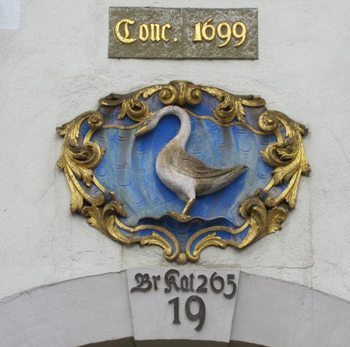
Set about midway between Dresden and Bad Schandau is the endearing town of Pirna. Bernardo Bellotto certainly thought it worth spending time in for as well as painting Dresden he also left us views of Pirna, including the Marketplatz and its cheerful rathaus (town hall).
The breezy sundial decorating the Rathaus sets the tone for a town where every wall, doorway and window-frame seems to be embellished by painting or decorative reliefs, which makes meandering through its streets a visual treat. If you decided not to stay in Saxon Switzerland then Pirna and Görlitz would make perfect day trip pendants to the central magnificence of Dresden.
Green Meadows to Waters Edge
In many places along the Elbe green meadows run right to the water’s edge and a footpath and cycle track traces the river’s route from Schmilka-Hirschmühle through Bad Schandau and on to Pirna and eventually Dresden.
Occasionally it is necessary to cross from one side to the other, as for example opposite Königstein, but the route is a popular one with walkers and cyclists and small ferries transport passengers and their bicycles at these crossing points.
On our last full afternoon in Bad Schandau, we hired bikes and cycled down to Rathen, the village opposite the Bastei. Here we sat in the sun and had an ice-cream while watching a little girl stumble-run through long meadow grass before finally unbalancing and sitting down hard on her bottom, from where she laughed up at her parents.
As we cycled back to Bad Schandau I felt a little sad that we were going to leave this happy corner of Germany the following day but then I remembered all that this region had offered and all that we had done in the short space of a week, and that we did not leave Dresden until late in the afternoon.

Travel to Dresden
The Dresden airport website has a page detailing information on travel to and from the airport. Tickets for city center rail transfers on S Bahn line S2 can be bought in the station itself or at the airport information desk in the Arrivals Hall.
The Deutsche Bahn website gives full details of rail travel in Germany. Mercifully for those hindered by a lack of even the most basic German, the ladies at the ticket offices spoke enough English to help with destinations, timetables, and platforms.
Trains from Dresden to Görlitz leave from Dresden Neustadt while from Dresden Hauptbahnhof it’s a straightforward run of about 50 minutes down the S Bahn line S1 to Bad Schandau. Note that the rail station at Bad Schandau is actually on the opposite side of the Elbe to the town.
The river is not wide here and a ferry connects the two banks through an extremely helpful feature of the Apparthotel Am Schlossberg is that it can arrange transport to and from the rail station. All you have to do is give reception details of your arrival and departure times.
Accommodation
Dresden Ibis Hotel (Lilienstein):
Apparthotel Am Schlossberg:
Museums and galleries in Dresden
All the information you could possibly need on the museums and collections of the Staatliche Kunstsammlungen Dresden (Dresden State Art Collections) can be found at this website.
Restaurants and cafes in Dresden
Altemeister cafe and restaurant
Italienisches Dörfchen
The Sophienkeller restaurant
Watzke Brauereiausschank am Goldenen Reiter
 Simon Glassock did a couple of things before deciding to read History at Oxford, and he is now an MRI radiographer with an active interest in travel, outdoor pursuits and writing.
Simon Glassock did a couple of things before deciding to read History at Oxford, and he is now an MRI radiographer with an active interest in travel, outdoor pursuits and writing.
- These 9 U.S. National Parks Require Reservations in 2024 - April 17, 2024
- Take a Hike in Olympic National Park - April 17, 2024
- The Wild Mississippi: 2340 Miles Across Ten States - April 8, 2024


